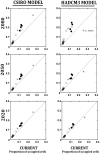Current and future niche of North and Central American sand flies (Diptera: psychodidae) in climate change scenarios
- PMID: 24069478
- PMCID: PMC3777871
- DOI: 10.1371/journal.pntd.0002421
Current and future niche of North and Central American sand flies (Diptera: psychodidae) in climate change scenarios
Abstract
Ecological niche models are useful tools to infer potential spatial and temporal distributions in vector species and to measure epidemiological risk for infectious diseases such as the Leishmaniases. The ecological niche of 28 North and Central American sand fly species, including those with epidemiological relevance, can be used to analyze the vector's ecology and its association with transmission risk, and plan integrated regional vector surveillance and control programs. In this study, we model the environmental requirements of the principal North and Central American phlebotomine species and analyze three niche characteristics over future climate change scenarios: i) potential change in niche breadth, ii) direction and magnitude of niche centroid shifts, iii) shifts in elevation range. Niche identity between confirmed or incriminated Leishmania vector sand flies in Mexico, and human cases were analyzed. Niche models were constructed using sand fly occurrence datapoints from Canada, USA, Mexico, Guatemala and Belize. Nine non-correlated bioclimatic and four topographic data layers were used as niche components using GARP in OpenModeller. Both B2 and A2 climate change scenarios were used with two general circulation models for each scenario (CSIRO and HadCM3), for 2020, 2050 and 2080. There was an increase in niche breadth to 2080 in both scenarios for all species with the exception of Lutzomyia vexator. The principal direction of niche centroid displacement was to the northwest (64%), while the elevation range decreased greatest for tropical, and least for broad-range species. Lutzomyia cruciata is the only epidemiologically important species with high niche identity with that of Leishmania spp. in Mexico. Continued landscape modification in future climate change will provide an increased opportunity for the geographic expansion of NCA sand flys' ENM and human exposure to vectors of Leishmaniases.
Conflict of interest statement
The authors have declared that no competing interests exist.
Figures








Similar articles
-
Species-specific ecological niche modelling predicts different range contractions for Lutzomyia intermedia and a related vector of Leishmania braziliensis following climate change in South America.Parasit Vectors. 2017 Mar 24;10(1):157. doi: 10.1186/s13071-017-2093-9. Parasit Vectors. 2017. PMID: 28340594 Free PMC article.
-
Climate change and risk of leishmaniasis in north america: predictions from ecological niche models of vector and reservoir species.PLoS Negl Trop Dis. 2010 Jan 19;4(1):e585. doi: 10.1371/journal.pntd.0000585. PLoS Negl Trop Dis. 2010. PMID: 20098495 Free PMC article.
-
Predicted altitudinal shifts and reduced spatial distribution of Leishmania infantum vector species under climate change scenarios in Colombia.Acta Trop. 2014 Jan;129:83-90. doi: 10.1016/j.actatropica.2013.08.014. Epub 2013 Aug 26. Acta Trop. 2014. PMID: 23988300
-
Should sand fly taxonomy predict vectorial and ecological traits?J Vector Ecol. 2011 Mar;36 Suppl 1:S17-22. doi: 10.1111/j.1948-7134.2011.00108.x. J Vector Ecol. 2011. PMID: 21366771 Review.
-
Sand flies (Diptera: Psychodidae) in eight Balkan countries: historical review and region-wide entomological survey.Parasit Vectors. 2020 Nov 11;13(1):573. doi: 10.1186/s13071-020-04448-w. Parasit Vectors. 2020. PMID: 33176888 Free PMC article. Review.
Cited by
-
Atlas of Mexican Triatominae (Reduviidae: Hemiptera) and vector transmission of Chagas disease.Mem Inst Oswaldo Cruz. 2015 May;110(3):339-52. doi: 10.1590/0074-02760140404. Epub 2015 Mar 14. Mem Inst Oswaldo Cruz. 2015. PMID: 25993505 Free PMC article.
-
Environmental factors associated with the distribution of visceral leishmaniasis in endemic areas of Bangladesh: modeling the ecological niche.Trop Med Health. 2017 May 12;45:13. doi: 10.1186/s41182-017-0054-9. eCollection 2017. Trop Med Health. 2017. PMID: 28515660 Free PMC article.
-
Leishmaniasis in the United States: Emerging Issues in a Region of Low Endemicity.Microorganisms. 2021 Mar 11;9(3):578. doi: 10.3390/microorganisms9030578. Microorganisms. 2021. PMID: 33799892 Free PMC article. Review.
-
Predicting the geographic distribution of Lutzomyia longipalpis (Diptera: Psychodidae) and visceral leishmaniasis in the state of Mato Grosso do Sul, Brazil.Mem Inst Oswaldo Cruz. 2013 Dec;108(8):992-6. doi: 10.1590/0074-0276130331. Mem Inst Oswaldo Cruz. 2013. PMID: 24402151 Free PMC article.
-
Predicted distribution of Metaparasitylenchus hypothenemi (Tylenchida: Allantonematidae), parasite of the coffee berry borer.J Nematol. 2024 Aug 6;56(1):20240031. doi: 10.2478/jofnem-2024-0031. eCollection 2024 Mar. J Nematol. 2024. PMID: 39114457 Free PMC article.
References
-
- World Health Organization (2010) Report of a meeting of the WHO Expert Committee on the Control of Leishmaniases, Geneva, Switzerland 201.
-
- Killick-Kendrick R (1999) The biology and control of Phlebotominae sand flies. Clin Dermatol 17: 279–289. - PubMed
-
- Young DG, Duncan MA (1994) Guide to the identification and geographic distribution of Lutzomyia sand flies in México, the West Indies, Central and South American (Diptera: Psychodidae). Mem Amer Ent Inst. Gainesville: Associated Publishers. 881 pp.
-
- Ibáñez-Bernal S (2001) Notes on the Psychodidae (Diptera) of Belize: Subfamilies Bruchomyiinae and Phlebotominae. Ann Entomol Soc Am 94: 367–385.
-
- Ibáñez-Bernal S, May-Uc E, Rebollar-Téllez EA (2010) Two new species of phlebotomine sand flies (Diptera: Psychodidae, Phlebotominae) from Quintana Roo, Mexico. Zootaxa 2448: 26–34.
Publication types
MeSH terms
Grants and funding
LinkOut - more resources
Full Text Sources
Other Literature Sources
Medical
Miscellaneous

